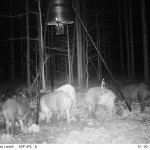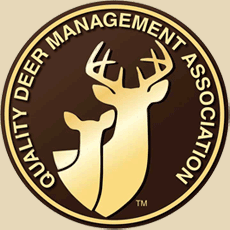When it comes to hunting and killing hogs more effectively nothing beats baiting. Feral hogs can be conditioned to coming to bait. It takes some time and a commitment, but effective baiting is perhaps the most effective method of hunting hogs in the southeast.
The bait of choice is corn, both shelled and cob work well to bring in pigs. Conditioning the pigs to the bait is essential for effective harvest practices. The two most basic methods are: timed feeders and hand baiting. We will get into the nuances of these styles shortly.
A regimen will usually involve pre-baiting a location for several weeks to condition the pigs to coming into specific bait. Then hunting that bait station to kill a hog. In many cases, once a hog is taken at a specific bait station, the remainder of the group will not return to that station for several days, often several weeks or even months. Successfully hunting hogs over bait requires many bait stations and a lot of bait. Having said this, it does seem that the use of archery equipment doesn’t seem to alarm the pigs nearly as much as does the report of a firearm.
Other than dry corn (on the cob or shelled) There is much debate on other types of bait. Sour corn, corn mash, molasses, Kool-Aid added to corn. Apples, pears, carrots, beets, sweet potatoes, etc. all will bring hogs into a location and they will feed heavily on it. Personally, I like shelled corn because this is affordable and works well in my automatic feeders. Occasionally I will use cob corn if I can find it at a good price, and often when setting up a new location, I will use sour corn to help the pigs find the location. Sour corn emits a very strong and pungent odor that pigs can smell a long way off. This will often help them to find a new bait site.
Back to the two most basic methods: Timed feeders are my personal preference for several reasons. They hold a lot of corn (Mine is a 55 gallon drum that holds 300 pounds) they can be programmed to emit as much or as little as I want, and it will keep feeding when I cannot make it down to the property to check on it. One full barrel will feed (depending on settings) for over a month. Through a lot of trial and error, I have learned to feed twice a day. An hour after daylight and an hour and a half before dark, will hopefully get the pigs to visit during the daylight. I will run the feeder for 2-3 seconds on high and medium speeds. The faster the spinner turns the further it throws the corn making them hunt harder for the food and keeping them there longer. Again, you will need to play with your settings to get the results you are wanting.
When hand baiting, I will take fresh bait to a location every other day and re-bait. If the bait is still there from before I leave it alone. If it’s all gone, I re-bait, check the cameras to see what ate it and then move on. I will usually use cob corn here and never get off of my ATV and just dump it at a site.
As stated earlier, if I am trying to establish a new bait site, I will use sour corn to get their attention. My method for sour corn is very simple. I fill a five gallon bucket with shelled corn, then I fill the bucket with water, put a lid on it and set it in the sun for several days (NOTE: make sure your lid can breathe or the fermenting process can cause the bucket to swell and blow the top off making a big mess) once the corn is sour, I take the whole mess out to the site and spread it around. The smell will draw pigs from a long range to the area. Again, there are many methods to doing this – some successful hunter I know will dig a deep hole with post hole diggers, and pour the sour corn into the hole, forcing the pigs to root around hard to get to the corn. Others use many other mixtures with the corn to draw the pigs in.
When establishing a bait site, I will always make the site in close proximity to an established stand. The pigs should be used to the stand location, now I am bringing them into range of the stand with the bait. My preference is 25 yards, but in some instances they are further, and some closer. One feeder is 34 yards from the stand – this is the extreme but the terrain dictated this situation. Others are twenty yards, from the blind or stand. Wind direction is critical as always.
When hunting hogs over bait, be patient, often it will take them several weeks to locate the bait, but usually once it’s located they will stay close by waiting on more. I always place a Bushnell Game Camera near a bait station to monitor the bait. When I see pigs coming in, I try and determine their direction of travel, and the time of day. When they are coming in at night, I often change the setting of the feeder to morning and mid-day to try and bring them in earlier before other animals eat the bait. It works about half of the time.
Regardless, it’s always exciting to see pigs on your camera, and knowing they are visiting your bait site can make for an exciting hunt. Even as the mercury rises, a cool morning sit on stand looking for feral hogs is a great way to spend the mornings. Plus you are helping your freezer, forest and other wildlife by removing them from the landscape.





